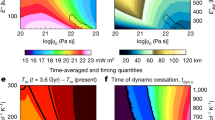Abstract.
Mars is the fourth planet out from the sun. It is a terrestrial planet with a density suggesting a composition roughly similar to that of the Earth. Its orbital period is 687 days, its orbital eccentricity is 0.093 and its rotational period is about 24 hours. Mars has two small moons of asteroidal shapes and sizes (about 11 and 6 km mean radius), the bigger of which, Phobos, orbits with decreasing semimajor orbit axis. The decrease of the orbit is caused by the dissipation of tidal energy in the Martian mantle. The other satellite, Deimos, orbits close to the synchronous position where the rotation period of a planet equals the orbital period of its satellite and has hardly evolved with time. Mars has a tenous atmosphere composed mostly of CO\(_2\) with strong winds and with large scale aeolian transport of surface material during dust storms and in sublimation-condensation cycles between the polar caps. The planet has a small magnetic field, probably not generated by dynamo action in the core but possibly due to remnant magnetization of crustal rock acquired earlier from a stronger magnetic field generated by a now dead core dynamo. A dynamo powered by thermal power alone would have ceased a few billions of years ago as the core cooled to an extent that it became stably stratified. Mars' topography and its gravity field are dominated by the Tharsis bulge, a huge dome of volcanic origin. Tharsis was the major center of volcanic activity, a second center is Elysium about 100° in longitude away. The Tharsis bulge is a major contributor to the non-hydrostaticity of the planet's figure. The moment of inertia factor together with the mass and the radius presently is the most useful constraint for geophysical models of the Martian interior. It has recently been determined by Doppler range measurements to the Mars Pathfinder Lander to be \(0.3662 \pm 0.0017\) (Folkner et al. 1997). In addition, models of the interior structure use the chemistry of the SNC meteorites which are widely believed to have originated on Mars. According to the models, Mars is a differentiated planet with a 100 to 200 km thick basaltic crust, a metallic core with a radius of approximately half the planetary radius, and a silicate mantle. Mantle dynamics is essential in forming the elements of the surface tectonics. Models of mantle convection find that the pressure-induced phase transformations of \(\alpha\)-olivine to \(\beta\)-spinel, \(\beta\)-spinel to \(\gamma\)-spinel, and \(\gamma\)-spinel to perovskite play major roles in the evolution of mantle flow fields and mantle temperature. It is not very likely that the \(\gamma\)-spinel to perovskite transition is present in Mars today, but a few 100 km thick layer of perovskite may have been present in the lower mantle immediately above the core-mantle boundary early in the Martian history when mantle temperatures were hotter than today. The phase transitions act to reduce the number of upwellings to a few major plumes which is consistent with the bipolar distribution of volcanic centers of Mars. The phase transitions also cause a partial layering of the lower mantle which keeps the lower mantle and the core from extensive cooling over the past aeons. A relatively hot, fluid core is the most widely accepted explanation for the present lack of a self-generated magnetic field. Growth of an inner core which requires sub-liquidus temperatures in the core would have provided an efficient mechanism to power a dynamo up to the present day.
Similar content being viewed by others
Author information
Authors and Affiliations
Additional information
Received 10 May 1997
Rights and permissions
About this article
Cite this article
Spohn, T., Sohl, F. & Breuer, D. Mars. The Astron Astrophys Rev 8, 181–235 (1998). https://doi.org/10.1007/s001590050010
Issue Date:
DOI: https://doi.org/10.1007/s001590050010




